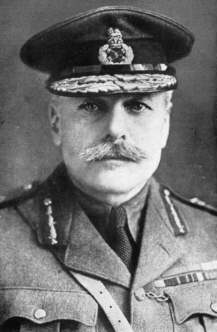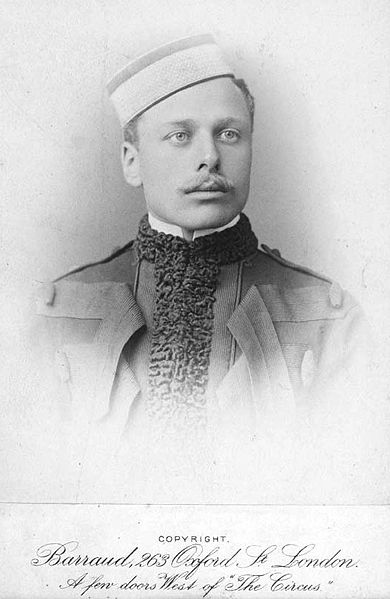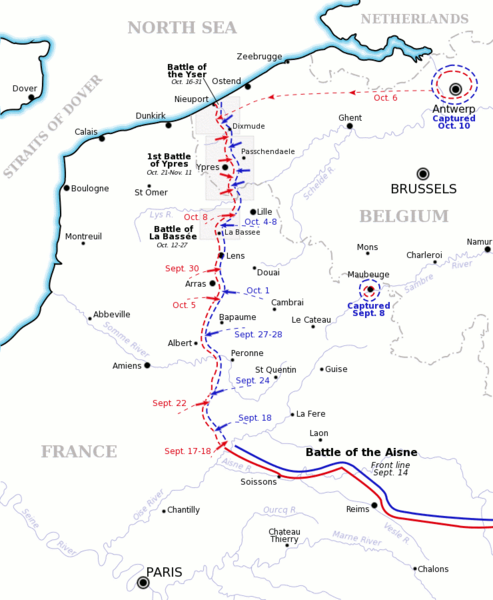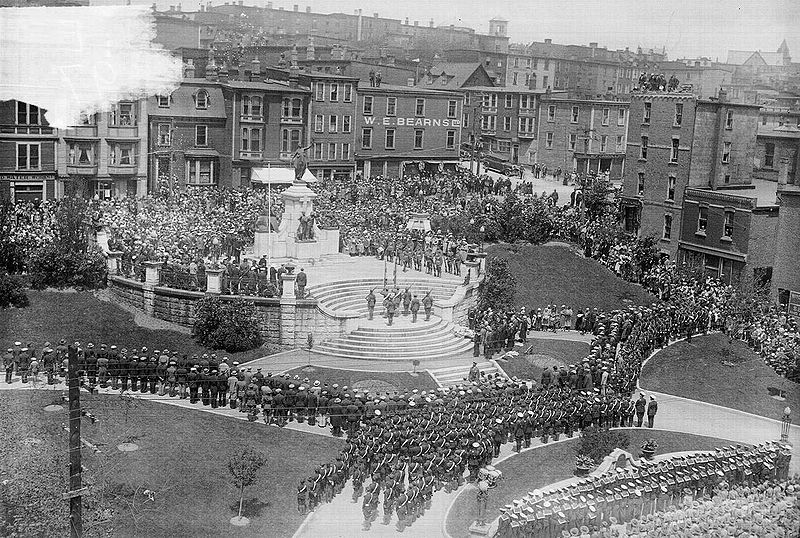<Back to Index>
- Jurist Hans Achim Litten, 1903
- Painter Cornelius David Krieghoff, 1815
- Field Marshal Douglas Haig, 1st Earl Haig, 1861
PAGE SPONSOR



Field Marshal Douglas Haig, 1st Earl Haig (19 June 1861 – 29 January 1928) was a British soldier and senior commander during World War I. He commanded the British Expeditionary Force (BEF) from 1915 to the end of the War. Most notably he was commander during the Battle of the Somme, the Third Battle of Ypres and the Hundred Days Offensive which led to the German surrender in 1918.
Although
a popular commander during the immediate post war years, with his
funeral becoming a day of national mourning, Haig has since the 1960s
become an object of criticism for his leadership during the First World
War. Alan Clark's book The Donkeys (1961) led to the popularisation of the controversial phrase 'lions led by donkeys'
which was used to describe British generalship. Clark attributed this
remark to a German general, but admitted he lied about the phrase
before his death. Academic historians and scholarship, since the 1980s, and many veterans, however, have continued to praise Haig's leadership. Haig married Dorothy (1879 - 1939), a daughter of Hussey Vivian, 3rd Baron Vivian, and a lady-in-waiting at the court of King Edward VII, on 11 July 1905. His
wife became Lady Haig in 1909 and the Countess Haig when her husband
was granted an earldom in 1919. The couple had four children. Haig first saw overseas service in India, in 1887, where he was appointed the regiment's adjutant in 1888, giving Haig his first administrative experience. In 1896 he was granted a special nomination to the Staff College, Camberley, a common practice in the day for promising candidates, despite being colour blind. He completed the course, leaving in 1897. He saw his first active service in Kitchener's Omdurman Campaign in 1898, where he was attached to the cavalry forces of the Egyptian Army, acting as Chief of Staff to brevet Lieutenant - Colonel Robert George Broadwood. He served in the Boer War in
further administrative positions with the cavalry, acting first as the
Deputy Assistant Adjutant General in 1899. Haig was employed briefly as
Chief Staff Officer to Major - General John French during the Colesberg operations, then as Assistant Adjutant General of the Cavalry Division. He was mentioned in despatches four times. His service in South Africa gained him prominence and the attention of French and Kitchener, both of whom would have important roles in World War I. In 1901, he became the commanding officer of the 17th Lancers, which he commanded until 1903. He was appointed Aide-de-Camp to King Edward VII in
1902, remaining in this position until 1904. After leaving the 17th
Lancers, Haig returned to India after Lord Kitchener was appointed Commander-in-Chief, India, and became Inspector - General of Cavalry. He was present at the Rawalpindi Parade 1905 to
honour the Prince and Princess of Wales visit to India. Haig's war
service had earned him belated but rapid promotion: having been a
captain until the relatively advanced age of thirty - eight, within five
years in 1904 he had become the youngest major general in the British Army at that time. Haig returned to Britain in 1906 as the Director of Military Training on the General Staff at the War Office. During this time, Haig assisted Secretary of State for War Richard Haldane in his reforms of the British Army, which was intended to prepare the army for a future European war. He took up the post of Director of Staff Duties in the War Office in 1907. A second return to India came in 1909, when he was appointed as Chief of the Indian General Staff. He was appointed GOC Aldershot Command from 1912 to 1914 and Aide-de-Camp to King George V in 1914. In the Army Manoeuvres of 1912 he was decisively beaten by Sir James Grierson despite
having the odds in his favour. On the outbreak of the First World War,
Grierson was appointed commander of II Corps (alongside Haig as
commander of I Corps) but died suddenly of natural causes before having
a chance to command in battle. Upon the outbreak of war in August 1914, Haig helped organise the British Expeditionary Force (BEF), commanded by Field Marshal Sir John French. As planned, Haig's Aldershot command was formed into I Corps, giving him command of half of the BEF. Tensions quickly exploded between Haig and French. Haig and Lord Kitchener, who was now Secretary of State for War, clashed with French over the positioning of the BEF. French argued to the war council that it should be positioned in Belgium, where
he had confidence in the country's many fortresses, while Haig and
Kitchener proposed that the BEF would be better positioned to
counter attack in Amiens, stating that the BEF would have to abandon its positions in Belgium once the poorly equipped Belgian Army collapsed, forcing the BEF into retreat with the loss of much of its supplies.
During a royal inspection of Aldershot, Haig had told King George V
that he had "grave doubts" about French's military competence. The BEF landed in France on 14 August and advanced into Belgium, where French intended to meet General Lanrezac's French Fifth Army at Charleroi. During the advance the BEF experienced their first encounter with the Germans at Mons on
23 August. During the battle the BEF were forced to withdraw, causing
Lanzerac to order a retreat exposing the BEF's right flank. The retreats of I and II Corps had to be conducted separately because of the Mormal Forest. Both corps were supposed to meet at Le Cateau but I Corps under Haig were stopped at Landrecies,
leaving a large gap between the two corps. Haig's reactions to his
corps' skirmish with German forces at Landrecies caused him to send an
exaggerated report to French, which caused French to panic. The
following day 26 August, Horace Smith - Dorrien's II Corps engaged the enemy in the Battle of Le Cateau, which was unsupported by Haig. This battle slowed the German army's advance. On 25 August the French commander Joseph Joffre ordered his forces to retreat to the Marne,
which compelled the BEF to further withdraw. The retreat caused Sir
John French to question the competence of his Allies resulting in
further indecision and led to his decision to withdraw the BEF south of
the Seine.
On 1 September Lord Kitchener intervened by personally visiting French
and ordering him to re-enter the battle and coordinate with Joffre's
forces. The battle to defend Paris began on 5 September and became known as the first Battle of the Marne.
The BEF did not participate in the battle until 9 September. The
following day the battle ended when the German advance was defeated.
The Germans abandoned the Schlieffen Plan and they were forced to withdraw to the Aisne. Following the defensive successes at Battle of Mons and Ypres (1st Battle of Ypres), Haig was promoted to full general. In December 1914 the I Corps were expanded into the British First Army and Haig was given command.
In December 1915, Haig replaced French as Commander-in-Chief of
the BEF, with French returning to Britain. Haig had been conspiring
towards the removal of French as commander of the BEF and had told King George V that French was "a source of great weakness to the army and no one had confidence in him any more".
From 1 July to 18 November 1916, Haig directed the British portion of a major Anglo - French offensive, the British offensive at the Somme. The time and place of the battle had been decided by the French, who
were attempting to relieve the pressure on the French Army at Verdun.
The French insisted that Haig continue the offensive on the Somme and
their insistence continued throughout the duration of the battle, even
after the French went on the offensive at Verdun in October 1916. The
forces under his command sustained an estimated 420,000 casualties
while pushing the German front line back 12 km (7 miles). The
campaign also resulted in heavy casualties to the German Army that it
could ill afford. Haig's tactics in these battles were considered
controversial by many, including the then Secretary of State for War Lloyd George,
who felt that he incurred unnecessarily large casualties for little
tactical gain. However, Lloyd George was unable to intervene in
strategy, as only Sir William Robertson, Chief of the Imperial General Staff had been given direct right of access to the Cabinet, in order to bypass Lloyd George's predecessor Kitchener. On 1 January 1917, Haig was made a field marshal. The King (George V) wrote him a handwritten note ending: "I hope you will look upon this as a New Year's gift from myself and the country". However, Lloyd George, who had become Prime Minister in
December 1916, infuriated Haig and Robertson by placing Britain's
forces under the command of the new French Commander-in-Chief Robert Nivelle at
a stormy conference at Calais. The failure of the Nivelle Offensive in
April 1917 (which Haig had been required to support with a British
offensive by Allenby's Third Army at Arras), and subsequent French
mutiny and political crisis, discredited Lloyd George's plans for Anglo
- French co-operation for the time being. During the second half of 1917 Haig conducted another major offensive at Passchendaele (the
3rd Battle of Ypres). Haig had two objectives and one issue in mind
when he set out the battle plans. The first of his objectives was to
commit a large contingent the German Army to Belgian Flanders, away
from the Aisne sector in France, where the aforementioned mutiny was
worst, in order to give the French time to recover. The second
objective was that he had hoped to break through and liberate the North
Sea coast of Belgium from which German U-Boats were operating. The
British Admiralty led by Jellicoe believed that the U-Boat threat could jeopardise Britain's ability to continue fighting into 1918. In addition to his two immediate objectives, Haig was also worried that the Russian Revolution would
result in Russia and Germany making peace and forming an alliance. If
this happened the million or so German troops located on the Eastern
Front would be transferred to the west by late 1917 or early 1918. This
would have certainly motivated him in his eagerness to secure a
decisive victory. Unfortunately,
like the Somme Offensive the previous year, Passchendaele resulted in
huge casualties for very little territorial gain, although at the same
time inflicting enormous losses on the Germans, which contributed to
their ultimate defeat. When he asked the Canadian Corps commander Arthur Currie to
capture Passchendaele Ridge during the final month of the battle,
Currie flatly replied "It's suicidal. I will not waste 16,000 good
soldiers on such a hopeless objective". After
Passchendaele was captured the number of casualties were almost exactly
what Currie had predicted. Although Lloyd George was unhappy about
Haig's strategic operations he was unable to do anything about it, as
it was considered unthinkable for politicians to overrule the generals'
professional monopoly over strategy during war. The
final months of 1917 also saw a tank breakthrough at Cambrai, whose
gains (after the church bells had been rung in England in celebration) were retaken within days by the Germans using their new 'sturmtruppen' tactics.
The uninspiring results on the Western Front in 1917 were thrown into
unwelcome contrast by Allenby's capture of Jerusalem in December 1917,
a propaganda coup from a campaign which Haig and Robertson had regarded
as a waste of resources (Allenby had in fact been sent out to the
Middle East after his failure at Arras earlier in the year). By the end
of 1917 Lloyd George felt able to begin to assert his authority over
the generals. Haig was required to dismiss his Chief of Staff,
Lieutenant - General Launcelot Kiggell,
and his intelligence chief, Brigadier - General Charteris, whose
overly optimistic estimates of German losses had been a source of
inspiration during Haig's offensives. Robertson had arrived at Haig's
Headquarters with orders (signed by the Secretary of State for War) for
these officers' dismissal in his pocket in case Haig refused to do as
he was asked. Early in 1918 Robertson was himself forced to resign over
his reluctance to accept that the newly set-up Supreme Allied War
Council at Versailles should have power to dictate to the British CIGS
(Lloyd George had also secured the dismissal of the other service chief, First Sea Lord Admiral Jellicoe).
Haig's predecessor Sir John French was invited to give the Cabinet a
"second opinion" of Haig's strategy, although in the event he had few
positive suggestions to make and seemed to the Cabinet Secretary
Maurice Hankey to be full of "hatred, envy and malice". The Cabinet
Minister Jan Christiaan Smuts was
sent to France to take discreet soundings among the Army Commanders to
see whether any of them were willing to replace Haig - none of them
were. Lloyd George was later to be accused (in the famous Maurice
Debate in the House of Commons) of hoarding troops in the UK at this
time to make it harder for Haig to launch offensives, thus allegedly
contributing to the debacle of March 1918. In
1918, Germany's Western Front armies were reinforced to a strength of
almost 200 divisions by the release of troops from the Eastern Front,
and launched major offensives in the west, enjoying great initial
success, albeit with greater superiority of men and guns than Haig had
ever had for his own offensives. The first of these, Michael on 21
March 1918, almost destroyed Gough's Fifth Army, and threatened to
split the British forces apart from the French Armies; Haig, whose own
reserves had been massed in the north because of the danger of a German
breakthrough reaching the Channel Ports through which his armies were
supplied, accused the French Commander-in-Chief, Pétain,
of being "in a blue funk" as he threatened to retreat on Paris, and was
at last forced to accept the appointment of a Frenchman, Ferdinand Foch as
Allied Generalissimo (Supreme Commander), with power to commit reserves
of all nationalities wherever he saw fit. During the second German
offensive, Georgette in Flanders, Haig issued his famous order that his
men must carry on fighting "With Our Backs to the Wall and believing in
the Justice of our Cause". Ironically these two German offensives swept
over the very ground (the Somme and Passchendaele respectively) which
Haig's own offensives had gained at such cost in previous years. A
third major German offensive against the French on the Aisne in May
overwhelmed a British corps which had been sent there to refit after
Michael. By
the summer the German offensives were losing momentum, and in July and
August the Germans were defeated, by Franco - American forces at the Second Battle of the Marne, and by Rawlinson's Fourth Army at Amiens. The latter victory, at which tanks were extensively used, was described by General Erich Ludendorff as
"The Black Day of the German Army" after mass surrenders of German
troops. Haig's forces had much success between then and the end of the
war, storming the Hindenburg Line in
October and advancing into Belgium, almost as far as Brussels. There is
some dispute over how much direct operational control Haig maintained
at this time, Tim Travers in particular arguing that he allowed his
Army Commanders (Plumer, Byng, Horne, Birdwood and Rawlinson) a very
free hand, whilst at the same time Ferdinand Foch, whose role had
initially been confined to advice and deployment of reserves, was
exerting ever greater influence over strategy. However, the forces
under Haig's command achieved impressive results: whereas the French,
American and Belgian armies combined captured 196,700 prisoners of war
and 3,775 German guns between 18 July and the end of the war, Haig's
forces, with a smaller army than the French, engaged the main mass of
the German Army and captured 188,700 prisoners and 2,840 guns - around
half of these prisoners were captured by British cavalry. The military
historian, Gary Sheffield, called this, the so called Hundred Days Offensive, 'by far the greatest military victory in British history'.
During the war, Haig suffered from toothache and
sent for a Parisian dentist. Consequently, within months the army had
hired a dozen dentists and, by the end of the war, there were 831. This
led to the formation of the Royal Army Dental Corps in 1921. After the war, Haig was created 1st Earl Haig (with a subsidiary viscountcy and a subsidiary barony) and received the thanks of both Houses of Parliament. Haig was Commander-in-Chief of the Home Forces in Great Britain. After ceasing active service, he devoted the rest of his life to the welfare of ex-servicemen, travelling throughout the British Empire to promote their interests. He was instrumental in setting up the Haig Fund for the financial assistance of ex-servicemen and the Haig Homes charity
to ensure they were properly housed; both continue to provide help many
years after they were created. An avid golf enthusiast, Haig was
captain of the Royal and Ancient Golf Club, St. Andrews 1920 - 21. He was involved in the creation of the Royal British Legion, which he was president of until his death and was chairman of the United Services Fund from 1921 until his death. He maintained ties with the British Army after his retirement; he was honorary colonel of the 17th/21st Lancers (having been honorary colonel of the 17th Lancers from 1912), Royal Horse Guards, The London Scottish and the King's Own Scottish Borderers. He was also Lord Rector and, eventually, Lord Chancellor of the University of St Andrews. Haig died, aged 66, on 29 January 1928 and was given a state funeral on 3 February. "Great
crowds lined the streets ... come to do honour to the chief who had
sent thousands to the last sacrifice when duty called for it, but whom
his war worn soldiers loved as their truest advocate and friend." The gun-carriage that carried the Unknown Warrior to
his grave and, in active service, had borne the gun that fired the
first British shot in World War I took the field marshal's body from St
Columba's Church, Pont Street, London, where it had been lying in
state, to Westminster Abbey. Three royal princes followed the gun-carriage and the pall bearers included two Marshals of France (Foch and Pétain). The
cortege was accompanied by five guards of honour at the slow march,
with reversed arms and muffled drums: two officers and fifty other
ranks from each branch of the British armed forces (Royal Navy, the Irish Guards, and the Royal Air Force); 50 men of the 1st French Army Corps; and 16 men from the Belgian Regiment of Grenadiers. After the service at the Abbey, the procession re-formed to escort the body to Waterloo Station for the journey to Edinburgh where it lay in state for three days at St Giles Cathedral. He was buried at Dryburgh Abbey in the Scottish borders, his grave marked by a simple standard Commonwealth War Graves Commission white headstone. The Earl Haig Memorial, an equestrian statue in Whitehall commissioned by Parliament, and sculpted by Alfred Frank Hardiman, aroused considerable controversy, and was not unveiled until just before Armistice Day in 1937. After the war Haig was praised by the American General John Pershing, who remarked that Haig was "the man who won the war". He
was also publicly lauded as the leader of a victorious army. His
funeral in 1928 was a huge state occasion. However, after his death he
was increasingly criticised for issuing orders which led to excessive
casualties of British troops under his command, particularly on the Western Front, earning him the nickname "Butcher of the Somme". Haig's critics include many younger officers who served in the First World War. Earl Haig Secondary School in Willowdale, Ontario, was named after Haig in 1928 Club Atlético Douglas Haig, a football club from Argentina, was named after him
Haig was born in Edinburgh, the son of John Haig, who was head of the family's successful Haig & Haig whisky distillery. Haig attended Clifton College and unusually for a British officer at that time attended university, studying at Brasenose College, Oxford,
1880 – 1883 where he studied Political Economy, Ancient History and
French Literature. He left without a degree, partially due to sickness,
and perhaps also as he would otherwise have been too old to enrol for
officer training in the Royal Military College in Sandhurst in 1883, from which he graduated the following year. However, Haig did pass his exams at Oxford. He was commissioned into the 7th (Queen's Own) Hussars the following year (1885) and promoted to lieutenant shortly afterwards.
